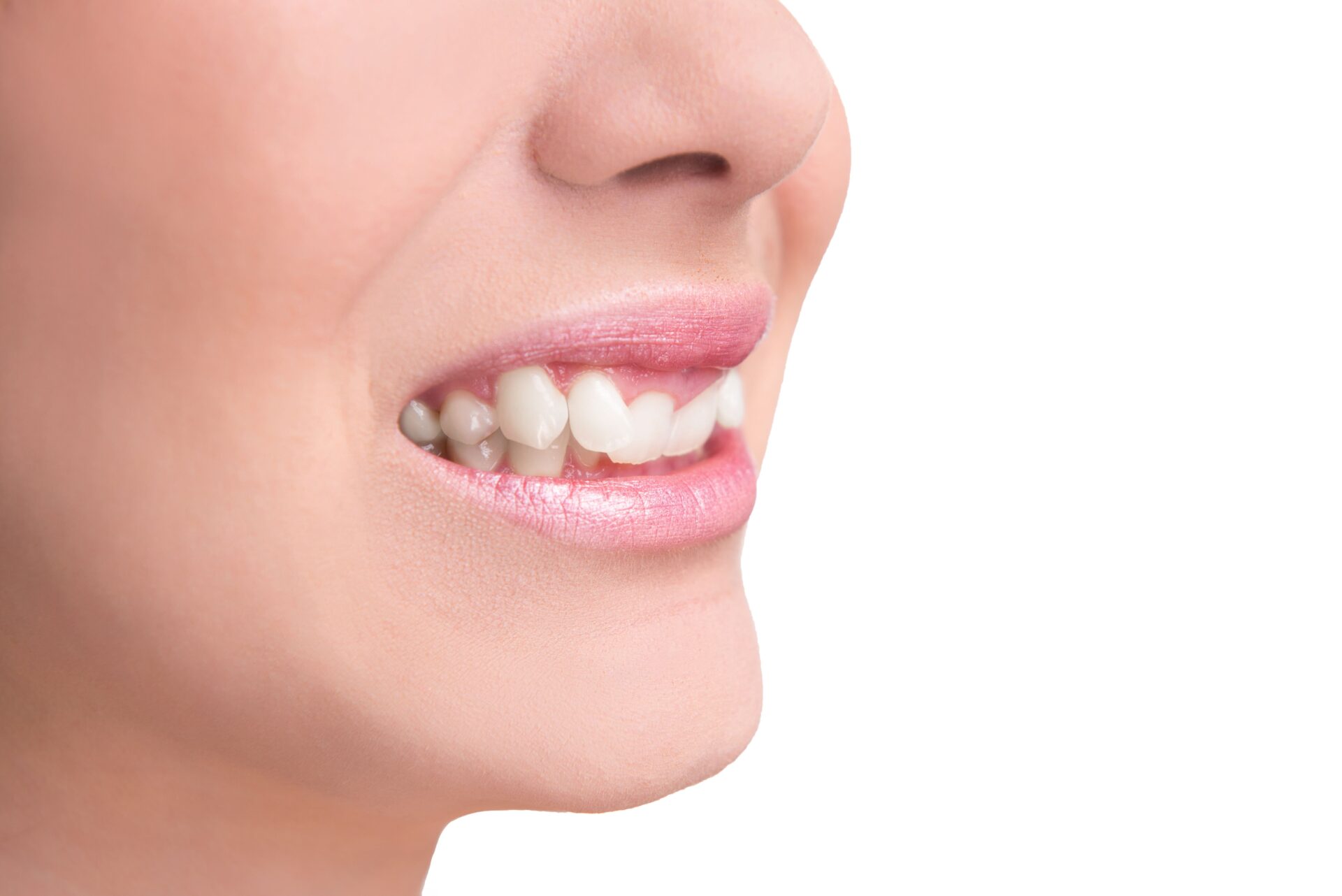In recent years, a term has made its way from niche orthodontic discussion to worldwide social media buzz: mewing. Originating from the mind of Dr. John Mew, mewing is described as a technique that can improve one’s facial aesthetics, especially the jawline, through a specific tongue posture.
Mewing has garnered significant popularity, particularly among teens and young adults. People share their transformative “mewing before and after” photos online, leading to curiosity and hope for non-invasive facial restructuring. However, despite its popularity and the many testimonials circulating online, the scientific community (including us here at Gullotta Orthodontics) remains sceptical about its claimed effectiveness, and there is little empirical evidence to support any of the claims.
What Is Mewing?
Mewing is a technique that involves a specific positioning of the tongue against the roof of the mouth where you close your lips and rest your tongue flat against the roof of your mouth with the tip just behind your upper front teeth, as if forming the “n” sound (see our how to mew section below for more detail). Supporters of mewing advocate for its potential to define the jaw, enhance breathing capabilities, and promote a more aligned bite, but again, there is scant empirical evidence to back these claims.
The concept of mewing was developed by Dr. John Mew (hence the name), a British orthodontist whose work extended beyond traditional orthodontics to explore the impact of tongue posture on facial development. Dr. Mew’s theories suggest that proper tongue placement can exert gentle, continuous pressure on the maxilla (upper jaw), potentially influencing bone structure and facial form. This idea forms the basis of what is today known widely as mewing, and has since been propagated by both his son, Dr. Mike Mew, and an enthusiastic online community. Dr. John Mew had his licence revoked by the General Dental Council in 2017 at age 89, and Dr. Mike Mew (the son) was expelled from the British Orthodontic Society in 2019 due to their controversial beliefs.
What Does Mewing Do?
It is claimed that mewing can lead to significant changes in one’s facial structure and health over time, including:
- Improved jawline definition. One of the most sought-after outcomes of mewing is a more defined jawline. It is believed that the upward and forward pressure exerted by the tongue reshapes the jaw, leading to sharper, more pronounced contours.
- Better breathing. Mewing is also claimed to improve nasal breathing by aligning the oral and nasal passages. This alignment allows for smoother air flow, potentially alleviating breathing difficulties for some individuals.
- Overall facial structure enhancement. Beyond the jawline, mewing enthusiasts claim that the technique can influence the entire facial structure. This includes higher cheekbones, a more prominent chin, and even changes to the alignment of the teeth, contributing to what is perceived as a more aesthetically pleasing appearance.
But does it really work? We review the evidence below.
Does Mewing Work? Examining the Evidence
The internet is full of “mewing before and after” anecdotes, where individuals share their personal experiences and transformations attributed to mewing. These narratives often include photographic evidence showcasing changes over months or years, highlighting enhancements in jaw definition, facial symmetry, and sometimes changes in the dental arch and profile. But this “evidence” of mewing should be taken lightly.
As of now, the orthodontic and scientific communities have not endorsed mewing as a reliable method for altering facial structure or achieving the orthodontic outcomes it claims to offer.
The consensus within the professional community is that while proper tongue posture is indeed important for oral health, the claims that mewing can drastically alter one’s facial appearance are not supported by scientific evidence.
The orthodontic community prioritises treatments and techniques backed by rigorous scientific research and clinical trials. To this end, professionals focus on methods that have demonstrated effectiveness and safety for patients. In contrast, mewing, largely propagated through social media and personal testimonies, has not undergone the level of scrutiny required for it to be adopted as a standard practice in orthodontics.
While the allure of a simple, cost-free method to enhance one’s appearance is undeniable, the absence of concrete scientific evidence to support mewing’s efficacy raises concerns.
How To Mew
The mewing tongue position involves having the entire tongue (including the back portion) pressing uniformly against the roof of the mouth. This position is maintained throughout the day and, ideally, becomes a subconscious habit. The aim is to ensure the tongue exerts a constant, gentle pressure across the maxilla (upper jaw), which, according to mewing advocates, can encourage facial restructuring over time.
Steps on How to Mew
- Flatten your tongue. The entire underside of the tongue should make contact with the roof of the mouth. This differs from the tip of the tongue touching just behind the teeth.
- Ensure complete contact. You should achieve full contact between the tongue and the palate. The pressure should extend from the tip of the tongue all the way to its back, pressing upwards against the soft palate.
- Maintain the jawline. While the focus is on the tongue’s position, maintaining a gentle closure of the mouth with teeth slightly touching can aid in reinforcing the mewing posture.
- Breathe normally. Proper mewing should allow for normal breathing through the nose. If nasal breathing is challenging when attempting to mew, it might indicate incorrect tongue positioning.
- Consistency is key. The potential benefits of mewing, as suggested by its advocates, depend significantly on the consistency of practice. The mewing tongue position should be maintained as much as possible throughout the day and ideally become an automatic habit.
While these steps outline the technique as advocated by mewing enthusiasts, the practice lacks comprehensive scientific validation from the orthodontic community. Orthodontists and dental professionals, including those at Gullotta Orthodontics, stress the importance of evidence-based treatments for structural changes to the jaw and facial aesthetics. As intriguing as mewing might be, individuals interested in altering their facial structure should seek professional consultation for safe and proven methods.
Safe Alternatives for Jawline Enhancement
Orthodontic experts, equipped with years of specialised training and experience, offer safe, effective alternatives for achieving desired jawline changes. These methods are grounded in scientific research and tailored to meet the individual needs of each patient. This not only prioritises your health and safety but also increases the likelihood of achieving successful, lasting results.
Several proven orthodontic methods can effectively address jawline issues, offering significant improvements in both function and appearance:
- Braces: Traditional braces are not only great at straightening your teeth but can contribute to a more symmetrical and aesthetically pleasing jawline over time.
- Clear Aligners: For those seeking a less conspicuous option, clear aligners, such as Invisalign and spark aligners offer a discreet way to adjust jaw alignment and achieve a more defined jawline without the visibility of traditional braces.
- Orthognathic Surgery: In cases where the jaw misalignment is severe, orthognathic surgery, often in conjunction with orthodontic treatment, can provide substantial improvements in both the functionality and aesthetics of the jawline.
Gullotta Orthodontics: Your Trusted Partner
While the promise of easy, non-invasive methods for enhancing facial aesthetics can be appealing, the safety and effectiveness of any orthodontic intervention should always be the priority.
At Gullotta Orthodontics, we provide expert, evidence-based orthodontic care, deeply rooted in a commitment to enhancing smiles and improving dental health. If you are curious about enhancing your facial aesthetics or have concerns about your jawline, contact us for a consultation. Let us be your guide and partner in achieving the beautiful, confident smile you deserve, through safe and professional orthodontic care.

